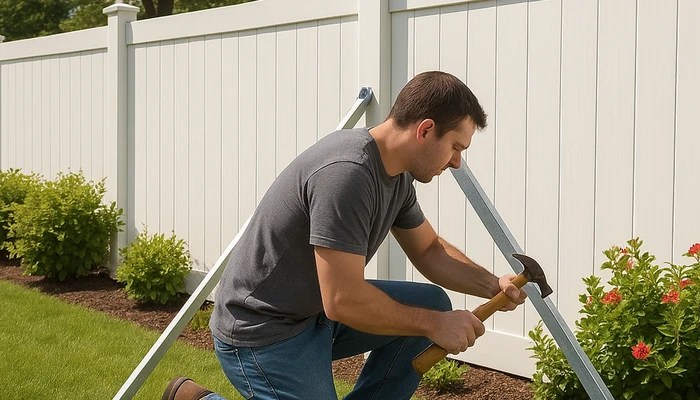Wind-Proof Your Vinyl Fence: Essential Tips and Tricks
Vinyl fencing is a popular choice for homeowners, property managers, and general contractors, thanks to its low maintenance and modern look. However, windy seasons and harsh winters—especially in the Chicago and suburban areas—can challenge even the toughest installs. This post is your expert guide to wind-proofing your vinyl fence, covering winter care, pet safety, budgeting for repairs, and practical design ideas.
Why Focus on Wind-Proofing Vinyl Fences?
While vinyl is strong, high winds common in the Midwest can loosen posts, crack panels, or shift fencing out of alignment. Preparing your fence for blustery weather helps protect not only your investment but also the safety of your property and pets.
Understanding Wind Exposure in Chicago
Chicago’s “Windy City” nickname isn’t just a saying: gusts regularly top 20 mph, with stronger windstorms each winter and spring. This exposure makes proper fence design and seasonal care crucial for lasting durability. If you’re interested in adapting designs for the local climate, review our in-depth post on vinyl fencing in different climates.
Table: Key Factors Affecting Vinyl Fence Wind Resistance
| Factor | Impact Level | Action |
|---|---|---|
| Post Depth & Anchoring | High | Set posts 3’+ deep, use concrete anchors |
| Panel Design | High | Choose semi-privacy or rail-reinforced styles |
| Material Quality | Medium | Opt for UV-resistant, thick-gauge vinyl |
| Maintenance | Medium | Inspect and clear debris seasonally |
| Permits/Code | Varies | Verify city or suburban codes before work |
Top Tips to Wind-Proof Your Vinyl Fence
- Set Posts Deep and Securely: For Chicago’s freeze-thaw cycles, all fence posts should be set at least 36 inches deep and anchored in concrete to prevent shifting and heaving.
- Choose the Right Fence Style: Solid privacy panels catch more wind. Consider semi-privacy or designs with wind gaps, as covered in our guide to vinyl fence design influence.
- Reinforce with Quality Materials: High-grade, UV-resistant vinyl and internal steel or aluminum stiffeners make a big difference. Learn more about UV resistance in vinyl fencing.
- Seasonally Inspect and Maintain: Check for loose caps, cracked panels, and leaning posts after storms. Remove heavy snow and debris to prevent stress fractures. See more easy ways to avoid vinyl fence damage.
- Account for Code and Permitting: Many Chicago-area municipalities require specific post depths or fence layouts for wind resistance. Always check with your local building department before starting work. Refer to industry standards on vinyl fencing for more insights.
Winter Care for Vinyl Fences
Winter in Chicago brings freeze-thaw cycles that can crack panels and shift posts. Clear snow from fence bases after storms and avoid letting ice build up around posts. For added protection, apply a gentle vinyl-safe cleaner to remove salt residue which can degrade material over time. When budgeting for winter prep, remember costs are lower than post-storm repairs. Read our post on understanding vinyl fence installation costs for more details.
Keeping Pets Safe Year-Round
Wind-damaged or loose panels can create escape routes for pets. Double-check gates and panels each season, and consider pet-focused fence features (like reinforced pickets or added base rails) if you manage properties with animals. You can personalize designs for safety on our vinyl fence customization options page.
Budgeting: Repairs vs. Preventive Care
Emergency wind repairs are typically three to five times more expensive than preventive anchoring and seasonal checks. Keeping a small repair fund as part of your property maintenance budget is smart—vinyl fencing’s durability generally leads to lower lifetime costs. More on the pros and cons of vinyl fences can help guide investment planning.
Smart Design Ideas for Wind & Weather
- Install decorative lattice tops to reduce wind loads while keeping privacy
- Use staggered panel heights for long fence runs
- Add steel or aluminum internal rails for extra reinforcement
- Leverage landscaping windbreaks (shrubs, hardy ornamentals) nearby fencing
When to Call a Pro
If you notice leaning posts, cracked panels, or persistent movement after a storm, professional evaluation is best. Licensed installers in the Chicago region will ensure your fence meets both local codes and industry safety requirements. For hands-on help, request a quote from our vinyl fence of Chicago team.
Learn More and Stay Informed
Keeping your fence wind-proof and durable is an ongoing effort. For updates on vinyl materials and safety developments, see industry news at the Plastics Industry Association’s news section.
Ready to upgrade your wind-resistant fencing? Contact our vinyl fence of Chicago experts for fast service and tailored recommendations.
About the Author
Reviewed by: Chicago Commercial Fencing Expert Team
With over 20 years of hands-on experience installing and repairing vinyl fences throughout Chicago and its suburbs, our team provides trusted, code-compliant solutions for homes, businesses, and multi-family properties. We believe in safety, durability, and transparent advice for every project.

Commercial Fence Company Chicago, Commercial Fence Company Chicago IL, Commercial Fence Chicago, vinyl best fencing of Chicago, vinyl best fence in the city of Schaumburg IL, vinyl fence in the city of Franklin Park IL, vinyl best fence in Addison IL, vinyl fence permit Elgin, vinyl fence secure Evanston IL, vinyl best fencing near Melrose Park
